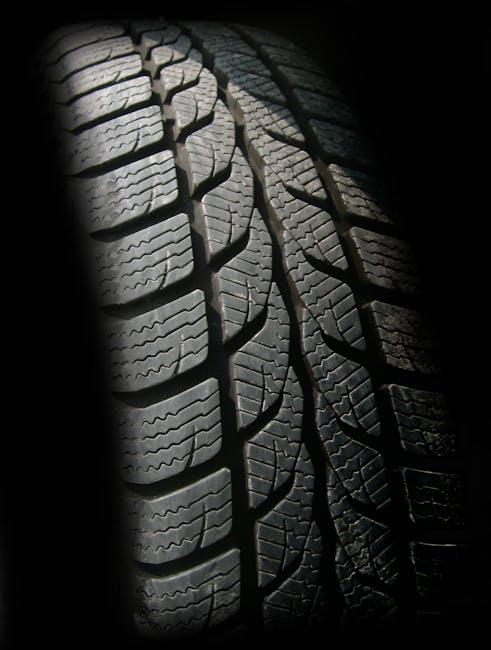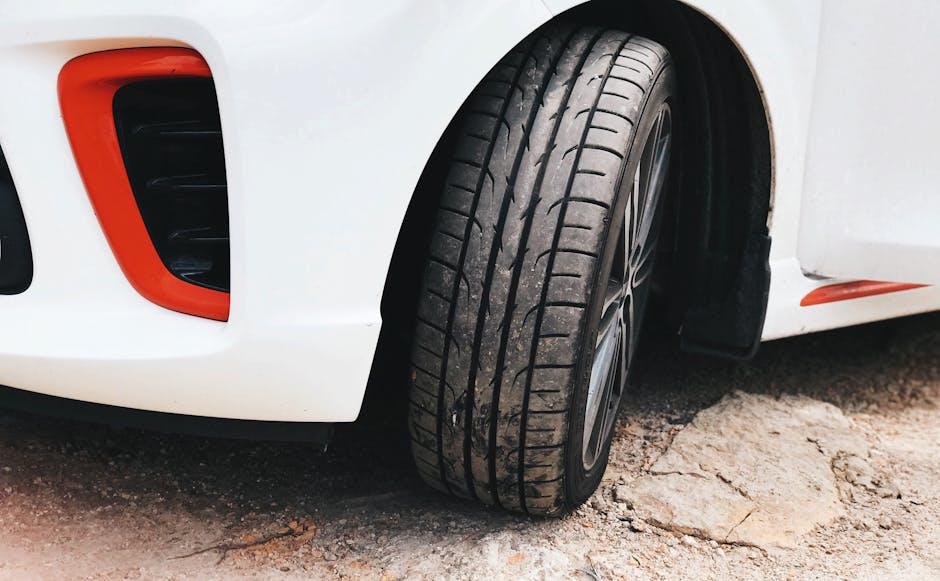Imagine standing beside your car, looking down at the tires and noticing a cryptic string of numbers and letters swirling around their sidewalls. To the untrained eye, these markings might seem like nothing more than random codes etched in rubber. Yet, hidden within these alphanumeric sequences lies a treasure trove of information—details about tire size, load capacity, speed rating, and manufacturing specifics—that can profoundly impact your driving safety and vehicle performance. Understanding how to read tire sidewall markings not only empowers you to make smarter purchases but also helps you maintain your tires properly, ensuring a smoother and safer ride. In this article, we will unravel the mystery behind those markings, guiding you through the essential knowledge every driver should have at their fingertips.
Table of Contents
- Understanding Tire Size Codes for Perfect Fit
- Decoding Load Index and Speed Ratings for Safety
- Unraveling Tire Manufacturing Dates and Longevity
- Interpreting Tire Type and Usage Indicators
- Recognizing Maximum Inflation Pressure and Load Limits
- Exploring Additional Sidewall Symbols and Their Meanings
- Q&A
- In Retrospect

Understanding Tire Size Codes for Perfect Fit
When selecting tires, understanding the alphanumeric code on the sidewall is essential for ensuring a perfect fit for your vehicle. These codes encapsulate critical details such as tire width, aspect ratio, construction type, and diameter. For instance, in a code like 205/55R16, 205 represents the tire’s width in millimeters, 55 indicates the aspect ratio (sidewall height as a percentage of width), R stands for radial construction, and 16 is the wheel diameter in inches. Each element works together to influence the tire’s performance, load capacity, and compatibility on your rims.
Here’s a quick reference to help decode the common elements found in tire sidewall markings:
- Load Index: Numeric value representing the tire’s maximum load capacity.
- Speed Rating: An alphabetical code indicating the maximum speed the tire can safely handle.
- Treadwear, Traction, and Temperature Grades: Ratings that guide you on the tire’s durability, grip, and heat resistance.
| Code Segment | Meaning | Example |
|---|---|---|
| Width (mm) | Measurement across the tire tread | 205 |
| Aspect Ratio (%) | Height of the sidewall relative to width | 55 |
| Construction Type | Type of tire construction | R (Radial) |
| Wheel Diameter (inches) | Size of the rim for mounting | 16 |

Decoding Load Index and Speed Ratings for Safety
Every tire you glance at hides a crucial code: the load index and speed rating. The load index is a numerical value that tells you the maximum weight a tire can safely carry. Imagine it as a strength badge – the higher the number, the more weight the tire supports. Choosing tires with the right load index is critical, especially if you frequently drive with heavy loads or multiple passengers, as underestimating this can compromise your vehicle’s stability and safety.
Right beside the load index, you’ll spot the speed rating, a letter that indicates the maximum speed capability of the tire. This isn’t an invitation for speeding but a guarantee that the tire can handle certain speeds without risk of failure. For example, a rating of “H” means the tire can safely reach speeds up to 130 mph, while “Q” stands for 99 mph. To help you decode these, here’s a quick reference:
| Speed Rating | Max Speed (mph) |
|---|---|
| L | 75 |
| M | 81 |
| Q | 99 |
| H | 130 |
| V | 149 |
| W | 168 |

Unraveling Tire Manufacturing Dates and Longevity
Decoding the manufacturing date of a tire is crucial for understanding its safety and effectiveness. Hidden in the humble letters and numbers on the tire sidewall is the DOT code, a four-digit sequence representing the week and year the tire rolled off the production line. For example, 2319 means the tire was made in the 23rd week of 2019. This insight helps you track your tire’s age, since rubber compounds degrade over time regardless of tread depth.
When assessing tire longevity, consider that most experts recommend replacement every 6 to 10 years from the manufacture date, even if the tread appears intact. Environmental factors such as heat, sunlight, and storage conditions play a role in tire wear and safety. Here’s a quick reference to understand typical tire lifespan under normal usage:
| Age of Tire | Expected Condition | Action Recommended |
|---|---|---|
| 0-3 Years | Optimal Performance | Check tread; safe to use |
| 4-6 Years | Good Condition with Wear Signs | Monitor regularly |
| 7-10 Years | Potential Rubber Hardening | Consult a tire professional |
| 10+ Years | Risk of Failure | Replace immediately |
- Check the DOT code: The last four digits tell you the week and year manufactured.
- Factor in mileage: Even newer tires with high mileage might require replacement.
- Consider storage: Tires kept indoors and away from UV light last longer.

Interpreting Tire Type and Usage Indicators
When you examine a tire’s sidewall, you’ll find a series of letters and numbers designed to communicate critical information about the tire’s type and intended use. For instance, the letter “P” before the tire size indicates it’s a Passenger tire, suitable for everyday cars, while the absence of this letter often means a tire designed for metric sizing systems or light trucks. Additionally, you might encounter codes like “LT”, which stands for Light Truck, pointing to tires engineered for heavier loads and tougher driving conditions.
Understanding these indicators allows drivers to select tires that match their vehicle’s requirements and driving style. Here are common tire usage indicators you might find:
- P – Passenger vehicle tire
- LT – Light truck tire
- ST – Special trailer tire
- XL/REIN – Extra load or reinforced for higher weight capacity
- M+S – Mud and snow tire, designed for improved traction in adverse conditions
| Indicator | Meaning | Typical Application |
|---|---|---|
| P | Passenger Tire | Compact cars, sedans |
| LT | Light Truck | Pickup trucks, SUVs |
| ST | Special Trailer | Boat trailers, utility trailers |
| M+S | Mud and Snow | All-season, light winter conditions |
| XL/REIN | Extra Load/Reinforced | Heavy-duty use, higher weight support |

Recognizing Maximum Inflation Pressure and Load Limits
When inspecting your tire sidewall, you’ll notice a sequence indicating the maximum inflation pressure. This figure is critical because it denotes the highest PSI (pounds per square inch) the tire can safely withstand. Overinflating beyond this limit risks tire damage and potential blowouts, while underinflation can cause uneven wear and reduced fuel efficiency. Remember, this number is a maximum threshold—not your recommended running pressure—so always consult your vehicle’s manual for optimal settings instead of inflating to the tire’s maximum.
Adjacent to inflation pressure, you’ll find the load index number, which is crucial for understanding the maximum weight each tire can carry. This index corresponds to a specific weight value, often seen in a handy reference chart. For example:
| Load Index | Maximum Load per Tire (lbs) |
|---|---|
| 85 | 1,135 |
| 90 | 1,325 |
| 95 | 1,521 |
- Check the sidewall markings for these key values every time you replace tires or before long trips.
- Never exceed the published load index to maintain tire integrity and vehicle safety.
- Balance inflation pressures with load capacity to ensure a smooth, safe ride.

Exploring Additional Sidewall Symbols and Their Meanings
Beyond the basic size and load indexes, tire sidewalls are adorned with an array of symbols that reveal important information about the tire’s capabilities and recommended usage. For example, a mountain/snowflake symbol indicates that the tire meets specific performance criteria in snowy conditions, making it suitable for winter driving. Similarly, a DOT code gives insights into the tire’s manufacturing date and facility, ensuring transparency about the tire’s age and authenticity. Other markings can inform you about the tire’s traction and temperature grades, oil resistance, and even the type of materials used in its construction.
Familiarizing yourself with these symbols can elevate your tire knowledge and help you make informed decisions when purchasing or maintaining tires. Here’s a quick reference table illustrating some common sidewall symbols and their meanings:
| Symbol | Meaning | Purpose |
|---|---|---|
| ❄️ Mountain Snowflake | Winter Traction Certified | Indicates tire tested for performance in snow |
| DOT | Department of Transportation Code | Shows manufacturing details including date |
| Treadwear Number | Range: 100 and up | Measures tire durability and wear rate |
| Traction Rating | Grades: AA, A, B, C | Indicates tire’s braking ability on wet surfaces |
- Sidewall symbols aren’t just legal requirements; they serve as a guide to tire performance and safety.
- Regularly checking and understanding these markings ensures your tires meet your driving needs and local regulations.
Q&A
Q&A: How to Read Tire Sidewall Markings
Q1: What exactly are tire sidewall markings?
A1: Tire sidewall markings are the alphanumeric codes and symbols embossed on the tire’s outer edge. They serve as a tire’s “ID card,” revealing essential details like size, load capacity, speed rating, manufacturing date, and safety standards.
Q2: Why should I bother understanding these markings?
A2: Knowing how to read tire markings helps you select the right tires for your vehicle, maintain safety standards, optimize performance, and even check tire age or quality before purchase.
Q3: What does a typical tire size code look like?
A3: A common tire size might read like this: P215/65R15 95H. Each segment delivers specific information:
- P: Tire type (‘P’ for Passenger car)
- 215: Width of the tire in millimeters
- 65: Aspect ratio (height to width, as a percentage)
- R: Radial construction
- 15: Diameter of the wheel rim in inches
- 95: Load index (how much weight the tire can support)
- H: Speed rating (maximum speed capability)
Q4: How can I identify the tire’s manufacture date?
A4: Look for the DOT code, often found on the sidewall. The last four digits of the DOT code reveal the week and year of production. For example, “2319” means the tire was made in the 23rd week of 2019.
Q5: What is the difference between load index and speed rating?
A5: The load index is a numeric code specifying the maximum weight a tire can safely carry. The speed rating is a letter indicating the maximum speed at which the tire can operate safely under load. Both are critical for choosing tires that match your driving needs.
Q6: Can tire sidewall markings tell me about traction and temperature ratings?
A6: Yes. Many tires feature a Uniform Tire Quality Grading (UTQG) label showing traction (A, B, C) and temperature resistance (A, B, C). These ratings provide insights into grip on wet roads and heat resistance during use.
Q7: Are there any symbols I should watch out for?
A7: Yes, sidewalls may have various symbols, such as:
- M+S (Mud and Snow) for all-season tires
- Three-Peak Mountain Snowflake symbol indicating winter tire certification
- Manufacturer logos and specific model identifiers
Q8: What if the sidewall markings don’t match my vehicle’s manual specifications?
A8: It’s best to consult with a tire professional or your vehicle manufacturer before using mismatched tires. Using incorrect tires can impact safety, vehicle handling, and warranty validity.
Q9: How often should I check my tire sidewall markings?
A9: Regularly—especially when purchasing new tires, rotating tires, or assessing tire condition. This habit ensures your tires are well-suited and safe for your driving needs.
By decoding these tire sidewall markings, you unlock the story of your tires—how they perform, their safety limits, and their lifespan. Understanding this “language” is a small effort that drives a big impact on your road safety and vehicle performance.
In Retrospect
Decoding the story written on your tire’s sidewall transforms a routine inspection into a moment of insight and confidence. From understanding size to interpreting load ratings, each marking is a guidepost on your journey to safer, smarter driving. The next time you glance at your tires, you’ll see more than just black rubber—you’ll see a language that speaks volumes about performance, safety, and reliability. So, keep this newfound knowledge close; your tires are ready to tell their story whenever you’re ready to listen.

